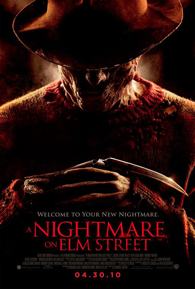
When a former humanities professor turned filmmaker Wesley Earl Craven created A Nightmare on Elm Street in 1984, little might he have known that he would pioneer the new subgenre of the dead teenager movie: psychological horror thrillers that centred around teenagers being stalked by a dangerous serial killer with the intention of spawning franchises upon franchises galore, Nightmare included. More than 25 years later, and here we are back to square one in the age of reboots (Star Trek, Batman, James Bond et al.), and who does the task of remaking Freddie fall to? Why none other than former music video veteran Michael Bay and his label Platinum Dunes, a niche horror label that has also rebooted The Texas Chainsaw Massacre and made the mediocre serial killer thriller Horsemen – both directed by music video veterans.
Anyway, this remake of the original Nightmare features almost the same overall plot structure. Nancy (Rooney Mara) and her friends all seem to realize that they are seeing the same spectral apparition: a badly-burned, blade-fingered man with a fedora, in their dreams. They soon realize that this apparition, the ghost of a suspect child molester called Freddie Krueger, is out to kill them in their dreams, causing their actual deaths in reality. As Freddie picks them off one by one, Nancy must struggle to survive Freddie's murderous rampage.
While visually and technically competent, somehow one suspects producer Michael Bay and director Samuel Bayer have not fashioned a horror film, but a suburban fantasy adventure instead. Consider that Wes Craven in the original deliberately avoided dramatic changes of lighting, music and scoring when transitioning between the "real world" his characters operated and the "dream world" where Freddie stalked them. This helped to create an effect in which the viewer becomes as confused as the characters, thereby plunging the viewer directly into their shoes.
Bay and Bayer offer no such luxury, indicating transitions into the dream world with dramatic shifts in lighting and background music, generally accompanied by the scenario of Freddie whisking his victims off to an apocalyptic industrial landscape of factories that do nothing except spew smoke and fire for dramatic effect – the sort of place where you expect Stallone, Seagal, Willis or Arnold to stage a shootout.
Bay and Bayer even spare us that most basic element of horror in the form of examining the darkness of the human heart. It is hinted at that Freddie may be an innocent man who was a victim of modern day lynching, which would render the angry parents that put him to death merely from suspecting their children's tall tales much more complex, but that is soon quickly dropped in favor of him being guilty as sin. The poorly characterized, nondescript teenagers each of whom has a personality that can be summed up in two lines, are overwhelmingly puritanical, and seemingly not even touched by sexual awakening yet – which makes them such paradigms of blameless innocence as to warrant their stalking by the paradigm of absolute child-molesting evil that is Freddie.
Evil stalking innocence makes for great fantasy novels and religious tracts, but rarely great horror stories. Therefore I have to conclude that Bay and Bayer were perhaps to their credit, not trying to make a horror movie at all but a battle of good and evil staged in the American bourgeois heartland.
This movie is a much different animal from Craven's original, and would most certainly be what fans of the original expect, but certainly when seen as a newbie with fresh eyes, it can be a moderately entertaining and well-made romp.

